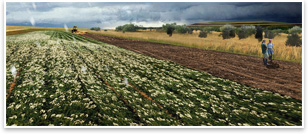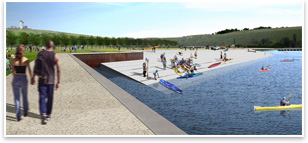
| Five Parks Grow out of One Huge Landfill on Staten Island Field Operations puts a park for everyone on top of the nation’s biggest dump
Summary: Fresh Kills Park in Staten Island is organized around capped and secured mounds of landfill trash in its five sections. Although it’s been designed for long-term flexibility, it will contain specifically programmed event spaces and wide open expanses on the scale of a national park. It will also be sustainably developed, with native plant species and on-site renewable energy features. The AIA’s resource knowledge base can connect you to a podcast of landscape architect and author Julie Moir Messervy dicussing her book, Outside the Not So Big House: Creating the Landscape of Home, which she co-authored with Sarah Susanka, FAIA. See what else SOLOSO has to offer for your practice.
From the magnificent to the sublime, Zuccotti Park in New York City, by Cooper, Robertson & Partners was one of five 2008 Urban Design Award recipients. Visit Field Operations’ Web site. Visit the New York City Department of Park and Recreation Fresh Kills Park Web site. See what the Committee on the Environment Knowledge Community is up to. Indeed, the rounded and graded mounds betray the hand of a conscious designer, or perhaps more appropriately, the waste of a distracted society made anew. Neises’ firm, Field Operations, has developed a master plan for Fresh Kills Park that will sit on top of what was recently the nation’s largest landfill. It will offer specifically programmed amenities like mountain biking, hiking, and kayaking—uses one doesn’t typically associate with parks in the nation’s largest city. But Neises says the three-and-a-half-square-mile park will still work on an expansive scale of wilderness and respite that has more in common with national parks. Like any national park, Fresh Kills’ development will be measured in decades, and Field Operations and the New York City Parks and Recreation department are looking 30 years ahead to a park that rehabilitates the land and finds a way to profit from past waste with onsite energy generation systems. It is designed and programmed for longevity and flexibility that will allow it to growth with always dynamic definitions of recreation. “The program for a park like this really evolves over time,” Neises says. “If you’re lucky enough that your park survives for 150 years, it will be converted to a new use anyway.”
New York-based Field Operations won a competition to master plan the park in 2003 and submitted a final design two and a half year ago. Some park and building projects are already under way, and the master planned elements by Field Operations won’t begin construction until spring or summer of 2009. The park will be divided into five sections, each one defined by how it uses mounds and the surrounding landforms. “One of the big design ideas was not to kill the scale of the park by distributing lots of little buildings and programs and elements throughout the entire site, but to use the topography to separate programs that might be thought of as incompatible,” Neises says. The sections of the park (except for The Confluence) will all have this mound feature, but will wrap them in varying contexts and uses.
Only native plant species (oaks, pitch pines, birches, native grasses, black locust) will end up in Fresh Kills Park. Neises and her team are trying to grow plants on-site as much as possible, as opposed to expending extra effort and energy by replanting mature trees. Some trees will even be harvested to create furniture for park facilities. Other sustainability practices will be using recycled material as much as possible. When the last two landfill mounds are capped and methane harvesting systems are installed, the park will be able to heat and fuel 25,000 homes. With the addition of other active renewable energy generation systems, Neises hopes the site will become a net energy producer. It’s more common to hear of architects turning heads with dazzling tales of their human-built creations that pay back their debt of carbon with renewable energy, but the landscape architects at Field Operations would like to see the earth they’ve worked on fulfill the same ambition. “If it’s mixed with a lot of clever strategies for doing things that are really quite green, it could change the way we think about the potential of landfills,” Neises says. |
||
Copyright 2008 The American Institute of Architects. All rights reserved. Home Page |
||
news headlines
practice
business
design
Photos courtesy of the architect.
See all of the images.

 How do you . . .
How do you . . . Avant
Gardeners
Avant
Gardeners The parks
The parks Working with the landfill
Working with the landfill